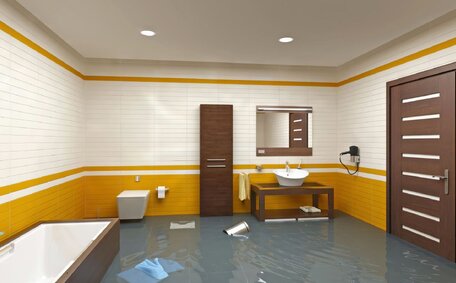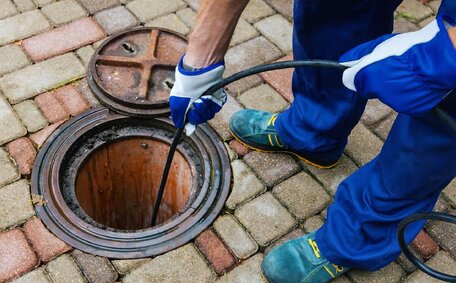Understanding Sewer Line Basics
Sewer lines, particularly the main sewer drain pipe, transport wastewater and sewage from residential and commercial properties to treatment facilities. Their optimal function is essential to prevent backup incidents that could lead to property damage or health risks.
Two types of lines prevent drainage issues:
- The main sewer line, often referred to as the main drain, connects your home’s plumbing system to the public septic system or septic tank.
- Secondary drain lines branch off from fixtures like sinks, showers, toilets, and even your washing machine to carry wastewater into the main sewer line.
Debris, grease, tree roots, or pipe shifts may clog your sewer drains. Address blockages promptly to avoid sewage backups, overflows, or total pipe failure.
Recognizing a Blocked Sewer Line
Several signs may indicate your main sewer line is clogged:
- Multiple plumbing fixtures backing up: If sinks, showers, bathtubs, and toilets in your home are all draining slowly or not at all, this points to a likely main sewer line clog.
- Foul sewer smells emanating from around drains, such as your shower, often result from a blockage that causes sewer gases to come up through your fixtures. A blocked sewer drain pipe allows gases and raw sewage to back up into the home.
- Gurgling sounds from your toilet or sinks, particularly noticeable when flush, are a classic indication of blockage issues. Noises indicate wastewater and sewage is having trouble passing through the pipes.
- Water pooling around sinks, toilets, a floor drain or a sewer cleanout outside the home, signalling a main line backup, often indicates a deeper issue.
- Consistently slow drainage from fixtures like your sink may suggest a main sewer line blockage.
Blocked drains do not resolve without intervention and can lead to overflows, property damage, and pipe failure. Contact a professional without delay if you suspect a blockage.
Multiple Drains Backing Up
When sinks, showers, and toilets begin getting backed up simultaneously, it often suggests there’s a blockage in your main sewer lines, beyond individual drain problems. Sewage and wastewater cannot properly flow out of the home, particularly from a shower bathtub, when there is a clog in the main line.
To check if water backs up shower or elsewhere, observe fixtures such as your toilet as it drains. Water your tub shower fixtures struggle to swallow, taking longer than usual to go down, is a red flag. Water filling up sinks or tubs and toilets that remain clogged after plunging all suggest the main sewer line can be obstructed.
Avoid using toilets or other drains during widespread backup to prevent worsening the situation. The wastewater has nowhere to go, which can make its way out your sewer pathways and risk overflowing sinks or toilets, flooding the home. Turn off running water and minimise usage until the main sewer line blockage can be cleared.
Foul Odors from Drains
Unpleasant sewage odours emanating from sinks, tubs, showers or floor drains are a common indicator of a main sewer line clogged. Gases produced by waste and sewage decomposing in backed-up pipes can start coming out through drains. This sewer gas smell is often described as a rotten egg odour.
Foul odours should not be ignored, as they can signal a blocked main sewer line. Contact a plumber immediately upon detection. Call a professional plumber promptly if you ever detect sewage smells to clear blockage issues.
A drain camera inspection will identify cracks in pipe interiors and the main water supply, which could permit gas leaks into the home. Damaged sewer lines require repair to fully eliminate odours and prevent toxic fumes entering living spaces.
Gurgling Noises from Drains
A gurgling sound emerging from sinks, tubs or shower drains when they’re not in use alerts to the common issue of a line being blocked. When water goes down another fixture, it displaces this trapped air, creating bubbling noises as air pushes up through the water.
Air gets trapped in the pipes due to a clog or partial blockage.
Sewage cannot flow freely through your sewer drains, allowing air pockets to form.
Promptly address clear main sewer line issues like gurgling drains to prevent further complications. Contact a qualified plumbing service to investigate and resolve persistent gurgling signs of potential blockages.
Partially blocked lines functioning temporarily can incur more debris, raising risks of severe blockages and overflows.
Causes of Sewer Line Blockages
There are several common culprits that can cause obstructions and blockages in sewer lines:
- Tree Roots: The tendrils and roots of encroaching vegetation can insidiously invade sewer pipe joints or cracks in their quest for moisture. Root masses grow over time, filling the pipes and severely limiting wastewater flow.
- Accumulated debris going down drain: Grease, fat, hair, and solid materials like paper towels or wet wipes that shouldn’t be flushed can build up on pipe walls over months or years.
- Pipe damage: Shifting foundations, ground movement, or corrosion can cause pipes to crack, sag and create blockages points.
- Pipes with an incorrect slope due to improper installation can cause waste to accumulate and insufficient drainage, potentially leading to sewage backup.
Contact a local plumber at the first sign of any problem within your sewer system.
Knowing the causes of sewer blockage facilitates early risk identification and prevents significant blockages.
Tree Roots
Tree roots are one of the most common causes of sewer line clogs and backflows. As roots grow they can infiltrate the smallest cracks and joints in sewer pipes seeking out water sources underground. Gradually, larger root masses accumulate to the point where they severely obstruct wastewater flowing through the line.
Older homes are more prone to root invasions as ageing pipes may sag, settle, or crack, creating entry points. But even tiny roots stemming from newly planted trees on your property can take advantage of the smallest openings.
Signs that may indicate a clog in your main sewer include gurgling drains, backups in multiple fixtures, and slow drainage. Specialised drain camera equipment is required to confirm root intrusion as the cause of blockages by visually inspecting the sewers. Tree root cutting and line clearing services are often necessary.
Ignoring root blockages can lead to sewage backups and strained plumbing fixtures, as well as pipe damage from pressure. We see the urgency, so contact Cherrybrook Plumbing as soon as you suspect roots may be compromising the integrity or flow of your sewer line before critical failure occurs.
Buildup of Debris
Debris such as grease, fat, and solids can build up in sewer pipes, leading to blockages. Your plumber would advise that grease and fat poured down sinks and drains gradually build up on pipe walls. Food scraps, wipes, feminine hygiene products and other solids get trapped, forming clogs.
Small debris buildup may initially go unnoticed, but can eventually accumulate enough to severely limit wastewater flow, indicating there’s a clog forming. Partial clogs also allow more debris to collect behind them. A minor obstruction can turn into a sewer line clogged once enough solids amass.
Being clear on what you can do with waste, avoiding washing down certain items, can help minimise debris sent to your sewer system.
Organise routine professional cleanings to clear debris and forestall significant blockages.
Pipe Damage
Sewer pipe damage can lead to significant blockages. Cracks or misalignments from ground shifting, tree roots, corrosion, or nearby construction allow waste to catch and collect. Even small cracks let water into your yard, undermining and washing away soil supporting pipes.
Symptoms of pipe damage include slowed drainage, multiple drain backups, gurgling sounds, and surface pooling if pipes collapse. Severe damage also allows sewer gases to leak into the surrounding soil or even into your home.
Repairs for damaged drain pipes often require replacement of entire sections. Pipe relining is another option that essentially inserts new piping within the damaged old pipes. Identifying and fixing damage early on prevents much more extensive and costly solutions later.
Preventing Future Blockages
There are several preventative measures you can take to avoid sewer line blockages at your floor drains and other points of your plumbing:
- Avoid pouring fats, oils and grease down any drain. Allow it to fully cool and solidify before disposing of it down your household garbage.
- Use drain strainers in sinks to catch hair, food and other debris before they can enter and clog your drain pipe.
- Never flush wipes, feminine hygiene products, diapers or paper towels. Use a trash can instead.
- Avoid using chemical drain cleaners that could harm the pipes draining your home. They can damage pipes over time.
- Trim back trees and plants near sewer lines to discourage root invasion.
- Flush pipes by running plenty of hot water during and after use to keep flow moving effectively.
- Schedule annual cleaning to remove minor buildup and prevent major clogs.
Precautions will minimise the risk of backups from debris in drains, but even diligent homeowners may face drain clogs. Keep an eye on drain performance and seek professional assistance quickly if issues arise.
When to Call a Professional
Even with meticulous maintenance, sewer line blockages are still possible. Knowing when to call a professional plumber is crucial to preventing further damage and costly repairs.
- Persistent gurgling or foul odours: If you frequently hear gurgling noises or notice unpleasant sewer smells coming from your drains, it’s time to call in the experts. These symptoms are a sign your sewer line may be clogged and require professional drain cleaning or repairs.
- Multiple fixtures backing up: If water backing up occurs in more than one plumbing fixture in your home simultaneously, these are signs your main sewer line may be impeded. Don’t delay when you see signs of a blocked sewer – contact Cherrybrook Plumbing for prompt assessment and clearing services.
- Water pooling around drains: Standing water around floor drains or cleanouts outside your home signals a main line backup. This is a serious issue that requires immediate attention from a professional plumber.
- Slow drainage throughout the house: Sluggish draining in multiple fixtures may suggest problems within your plumbing, potentially a partial or complete blockage in the main sewer line. Schedule an appointment with Cherrybrook Plumbing to investigate and address the problem before it worsens.
Remember, warning signs of a blocked sewer line affecting your house should not be ignored. Ignoring symptoms likely risks serious overflows, property damage from sewage backups, and main line failure. Contact Cherrybrook Plumbing at 1300 349 338 or [email protected] for expert diagnosis and clearing services.
Severity Assessment
Assessing the severity of sewer line clogs is critical for determining the right response. Mild symptoms like slightly slowed drainage or gurgling sounds when water flows down pipes may indicate a sewer drain clog. The line can often be cleared using a plunger, drain snake or commercial drain cleaner.
Persistent odours, multiple fixture backups, or visible pooling likely indicate a main sewer blockage requiring professional help. The longer a line clogged with severe blockages goes unchecked, the higher the risk of extensive damage from backups and overflows.
Expert technicians equipped with advanced diagnostic tools utilise high-pressure jet flushing to thoroughly clear stubborn sewer and drain clogs.
Professional Drain Cleaning
When faced with a severe sewer line blockage, professional drain cleaning services are often required to clear the clog. Cherrybrook Plumbing’s expert technicians utilise advanced tools and methods for thorough drain cleaning and restoration of unobstructed flow.
High-powered water jetting is an extremely effective method for cleaning drains that have clogged up with debris and build-up. We use specialised jetting nozzles that blast pressurised water to break apart and flush out debris, grease, roots and other blockages. For the sewer main care, smaller pipes like kitchen sinks may require the use of motorised drain augers or plumbing snakes equipped with rotating blades to mechanically shred clogs.
In cases of complete sewer failure, pipe relining may be necessary to install new piping without the cost and mess of full replacement. Cherrybrook Plumbing has commercial grade equipment to provide superior drain cleaning and repair services capable of tackling the toughest sewer and drain obstructions.
Sewer Line Repairs
If a professional inspection confirms your sewer line is severely damaged or blocked beyond basic drain cleaning capabilities, repairs or replacement are likely needed to restore proper function.
Typical repair options Cherrybrook Plumbing may recommend include:
- Pipe relining: Inserting a protective epoxy coating within damaged pipes to essentially create new piping without digging.
- Spot repairs: Replacing small sections of compromised piping.
- Full sewer line replacement: Installing entirely new piping when extensive damage exists.
The advised solution will be tailored to your main sewage line’s condition and the specific problem. As trusted experts, Cherrybrook Plumbing will explain what is needed to prevent ongoing issues and restore free flow to your sewer drain pipes.






